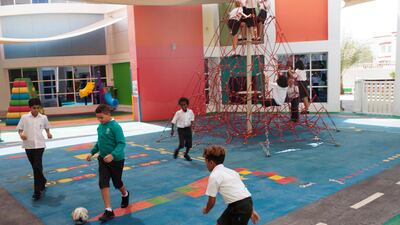Exercise habits developed at a young age can last a lifetime but warnings have also been sounded over the rising trend of teenagers lifting weights to achieve the perfect body image.
The need to get the balance right has prompted schools to turn to private fitness companies for advice on the safest way to improve the health of their pupils.
Kris Green is a fitness expert at the Physical Training Company and he is helping improve the health of young people at Dubai College and Gems Wellington schools.
He has helped develop a physical literacy programme at both schools, and says the mindset towards health and fitness is slowly changing.
“This programme runs alongside the curriculum to try to bring more of an understanding of the benefits physical fitness can bring to everyday life,” he said.
“The way the world is developing, exercise is no longer a natural part of growing up for many children in the UAE.”
In the UK, Mr Green, 29, worked with sporting academies to help develop the fitness of elite youngsters, whereas in Dubai his work is geared towards more general health improvements.
“It is a double-edged sword in the UAE as the weather and facilities are not conducive to natural outdoor play and the rise of technology has left children with less of a desire to play sport and exercise.
___________________
Read more:
Dubai school's 'mini boot camps' for children as young as 4
PE could be the first step towards a healthy nation
Intense school exercise and UAE-wide PE guidelines needed
'Don't be embarrassed, learn to swim,' adult learners say
___________________
“There is plenty of room for improvement, and the best time to get contact time with children is during school time.”
Part of the programme is to educate children on the science behind healthy living and the physical benefits, with the rest of the schedule dedicated to practical work.
Students take part in a 90-minute slot once a week, on top of the usual physical education curriculum.
Programmes can also be tailored to suit strength and conditioning work for specific sports, if the school deems it an area in need of improvement.
“I’m not sure children and young people are fully aware of the long-term damage a poor lifestyle is having,” said Mr Green.
“There has been interest from other schools, so it is clearly a growth area.”
Dr Noobi Koya, a specialist paediatrician at the Canadian Specialist Hospital in Dubai, said some teenagers who take on exercise are often more concerned about their image, rather than their health.
“Especially in boys, there is a problem with them doing weight training at a young age, which is not necessarily good for them while their bodies are still developing,” she said.
Back and shoulder injuries are becoming more common in teenage boys who are lifting weights in the gym, though most injuries are rectified with rest and anti-inflammatory medication. In more serious injuries, such as a prolapsed disc, where intervertebral discs are damaged, the effects can be long-term.
“While exercise in children is important, it is crucial to know they are more susceptible to injuries,” said Aditya Ghai, a physiotherapist at Zulekha Hospital.
“Young teenagers should not be weightlifting, as they are particularly vulnerable to muscle injuries. It is only safe under supervision when they are 17 or 18, so they can develop the correct posture.
“The main focus should be on a gradual strengthening and posture through a variety of exercise when young people are aged 12 to 13.
“Young patients come to me with lower back problems, and they are doing weight training unsupervised.
“This can also damage their confidence, as their mentality shifts from being healthy to looking good.”


